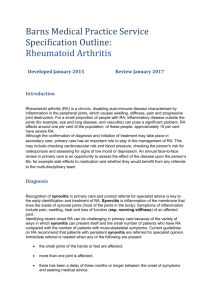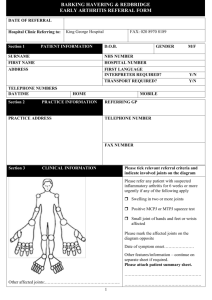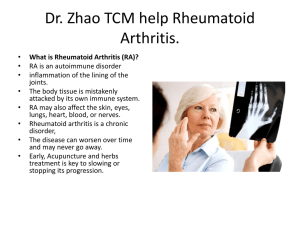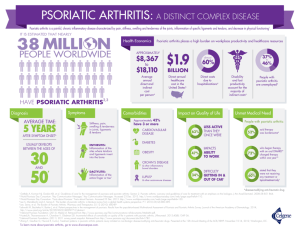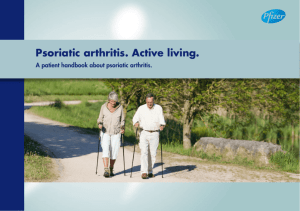Joint pain
advertisement
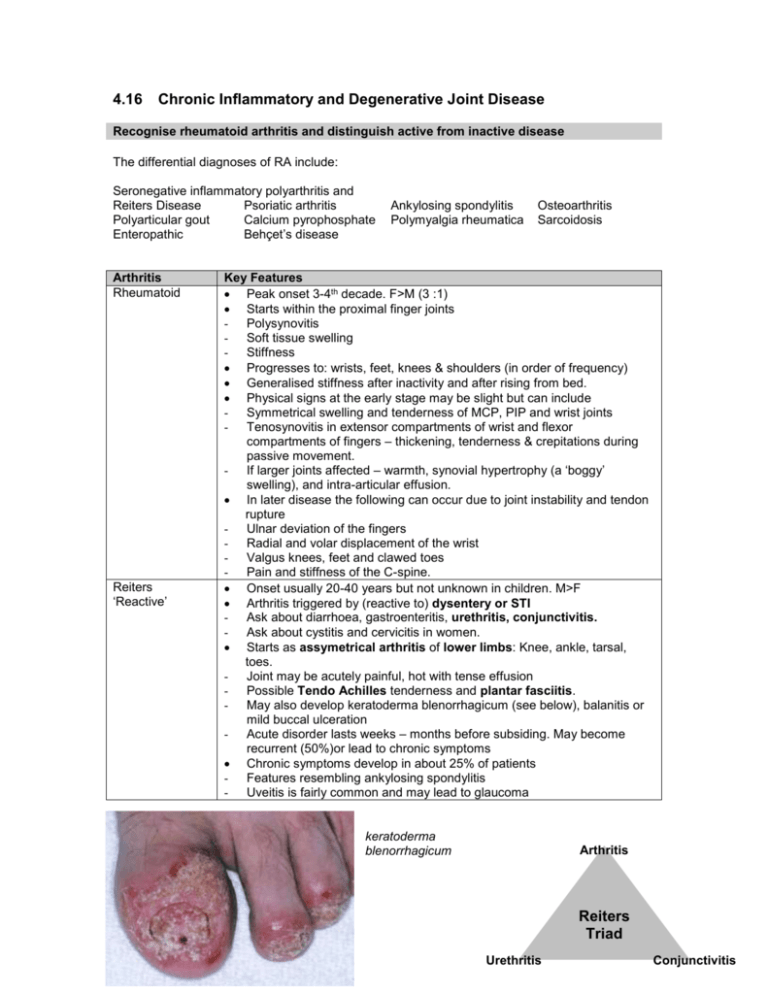
4.16 Chronic Inflammatory and Degenerative Joint Disease Recognise rheumatoid arthritis and distinguish active from inactive disease The differential diagnoses of RA include: Seronegative inflammatory polyarthritis and Reiters Disease Psoriatic arthritis Polyarticular gout Calcium pyrophosphate Enteropathic Behçet’s disease Arthritis Rheumatoid Reiters ‘Reactive’ Ankylosing spondylitis Polymyalgia rheumatica Osteoarthritis Sarcoidosis Key Features Peak onset 3-4th decade. F>M (3 :1) Starts within the proximal finger joints - Polysynovitis - Soft tissue swelling - Stiffness Progresses to: wrists, feet, knees & shoulders (in order of frequency) Generalised stiffness after inactivity and after rising from bed. Physical signs at the early stage may be slight but can include - Symmetrical swelling and tenderness of MCP, PIP and wrist joints - Tenosynovitis in extensor compartments of wrist and flexor compartments of fingers – thickening, tenderness & crepitations during passive movement. - If larger joints affected – warmth, synovial hypertrophy (a ‘boggy’ swelling), and intra-articular effusion. In later disease the following can occur due to joint instability and tendon rupture - Ulnar deviation of the fingers - Radial and volar displacement of the wrist - Valgus knees, feet and clawed toes - Pain and stiffness of the C-spine. Onset usually 20-40 years but not unknown in children. M>F Arthritis triggered by (reactive to) dysentery or STI - Ask about diarrhoea, gastroenteritis, urethritis, conjunctivitis. - Ask about cystitis and cervicitis in women. Starts as assymetrical arthritis of lower limbs: Knee, ankle, tarsal, toes. - Joint may be acutely painful, hot with tense effusion - Possible Tendo Achilles tenderness and plantar fasciitis. - May also develop keratoderma blenorrhagicum (see below), balanitis or mild buccal ulceration - Acute disorder lasts weeks – months before subsiding. May become recurrent (50%)or lead to chronic symptoms Chronic symptoms develop in about 25% of patients - Features resembling ankylosing spondylitis - Uveitis is fairly common and may lead to glaucoma keratoderma blenorrhagicum Arthritis Reiters Triad Urethritis Conjunctivitis Arthritis Psoriatic Key Features About 5% of psoriasis patients progress to this arthritis. May be the presenting complaint of psoriasis. - Usually diagnosed ages 30-50 (later than for psoriasis) - Psoriasis may be unnoticed (natal cleft, naval etc.) - Psoriasis best spotted on elbows and knees – extensor surfaces Ankylosing spondylitis - Onset typically ages 15-25. M>F (2-10 : 1) Differentials include: Reiters, psoriatic, Inflammatory bowel disease, Whipples disease and Behcets syndrome. Usually present with a chronic backache – a ‘red flag’ is that the pain is worse after rest. 10% present initially as a peripheral monoarthritis. May be accompanied by uveitis, aortitis (Rheumatoid aortitis is a true panarteritis. Histologically there is necrosis and fibrosis of the media, obliteration of the vasa vasorum and intimal thickening) ESR & CRP usually raised; blurring of upper and lower vertebral rim at thoracolumbar junction is earliest X-ray sign. In early disease the following may be seen: Flattening of the lower back due to vertebral fusion A compensating increased thoracic kyphosis. A decrease in spinal movements, especially extension A posture with hips extended and knees flexed to compensate. In later disease the following complications may occur Hyperkyphosis – may severely limit the ability to lift the head Spinal cord fracture – spine is often rigid and osteoporotic – minor injuries may cause fractures. X-ray entire spine. Spinal cord compression by atlanto-axial subluxation or calcification of the posterior longitudinal ligament. Neuro symptoms / signs. Lumbosacral root compression – lower limb weakness / parasthesia Background box: Atlanto-axial subluxation. C1 verterbrae is also called the Atlas; C2 is the Axis. Atlantoaxial dislocation. Lateral view of the cervical spine shows a marked increase in the distance between the anterior surface of the dens and the posterior surface of the C1 tubercle (blue arrow) that measured 14 mm (black line) well in excess of the 3 mm maximum in adults. The imaginary line connecting the spinolamina white lines (white line) shows that the body of C1 (red arrow) is displaced anteriorly relative to the remainder of the spine. Osteoarthritis Symptoms Joint Pain Stiffness/pain after immobility (<30 mins) Instability Loss of function Signs Joint tenderness Limited range of movement Instability Crepitus on movement Type Nodal Primary joints DIP>PIP; hip; knee Generalised nodal Knees, 1st MTP, hips and spondylosis Knees and wrists DIP & PIP Crystal-associated Erosive Bony swelling Joint effusion Muscle wasting Variable levels of inflammation Other features Slow onset over year Pain over time Often sudden and severe onset. Patchy linear calcification Marked subchondral cysts Functional outcome poor Pathology: Normally: cartilage replacement (by chondrocytes) = wear In OA: cartilage replacement (by chondrocytes) < wear Focal erosions occur and surface becomes fissured and fibrillated Underlying bone exposed – stress leads to microfractures and cysts Attempts at bony repair produce abnormal sclerotic subchondral bone and osteophytes. There is a strong genetic component Arthritis RA Reiters Psoriatic Main joints* Symmetrical PIP, MCP, Wrist Sacroiliac Summary Table On X-ray Erosive features Erosive features Erosive features AS Assymetrical IP joints of fingers / toes Sacroiliac (1/3rd of pts.) Sacroiliac OA Sarcoid DIP Symmetrical small joints Osteophytes Punched out ‘cysts’ Cortical erosions - Erosive features Other Features Rheumatoid nodules May be RF +ve Conjunctivitis Urethritis Foot dermatitis Psoriasis ‘square’ lumbar spine spinal extension Polymyalgia Pectoral and pelvic Muscular weakness rheumatica girdles ESR will be RF = Rheumatoid factor *Main Joints are those important diagnostically Enteropathic Synovitis Predominantly lower limb Occurs in 10-15% of those with IBD (UC or Crohns) May be the presenting complain for IBD May be independent of IBD activity May be abolished by definitive treatment of UC (or by the natural remission of this disease). Some indicators of active disease New rheumatoid nodules Muscle weakness adjacent to affected joint Neuropathy: median nerve compression caused by synovitis of the wrist; entrapment of the ulnar nerve at the elbow or branches of the sural nerve in the tarsal tunnel. Bloods: The erythrocyte sedimentation rate (ESR) and the C-reactive protein level are usually elevated. Remember – these are pretty non-specific. Mild normocytic, normochromic anaemia – also fairly non-specific. Imaging: Progressive, symptomatic interstitial pulmonary fibrosis that produces coughing and dyspnea in conjunction with radiographic changes of a diffuse reticular pattern (i.e., honeycomb lung) is usually associated with high titers of rheumatoid factor. The lesion is histologically indistinguishable from idiopathic pulmonary fibrosis. Chest radiographs show pleural thickening, nodules, diffuse or patchy infiltrates, and a restrictive ventilatory defect that is characterized by a decreased CO diffusion rate. These abnormalities are often associated with cigarette smoking, other extra-articular manifestations, and active disease. Types of Gout Acute Typical presentation is middle-aged male Sudden onset agonizing pain Swelling, redness Most often 1st MTP. May be precipitated by alcohol binge or certain food types. Alternately from dehydration of diuretic. Untreated recovery usually within 7 days Chronic polyarticular As above but recurrent. Rare except in: Renal failure Elderly + long standing diuretics Chronic tophaceous Very high serum urate levels Smooth white deposits in skin and around joints; on ear lobe and Achilles tendon. Chronic joint pain Occasional superimposed acute attacks. Associated with renal stones. Pseudogout (pyrophosphate arthropathy) Most common in elderly women Wrist and knee mostly affected Calcium pyrophosphate deposits in hyaline and fibrocartilage. Chondrocalcinosis on X-ray Factors that increase serum urate Age High blood pressure Family history Combined hyperlipidaemia Diabetes mellitus Ischaemic heart disease Alcohol Obesity High protein diet Describe the immunological basis of rheumatoid arthritis It is believed that there is a genetic susceptibility to RA, that combines with an environmental trigger. RA is more common in first degree relatives. HLA DR4 is found in 70% of RA patients (and only 30% of the normal population). In RA it is believed that T cells become activated against a surface antigen expressed by certain of the patients own cells. Recognise the multi-system manifestations of many auto-immune processes Diagnose and assess the severity of degenerative disease of the hip and knee Initiate appropriate investigations Initiate appropriate management, especially the relief of pain Background box: The WHO analgesic ladder 3 Increasing Pain 2 1 Strong Opioids +/- adjuvant therapy Weak Opioids +/- adjuvant therapy Regular Non-opioid +/- adjuvants Discuss with patients the range of aids to daily living that are available Describe the referral pathways for patients to physiotherapy and occupational therapy Recognise the need for surgical assessment Indications for surgery include: Severe chronic pain Severe joint destruction Fixed deformity Loss of function The three basic surgical procedures are: Arthrodesis (fusion of the joint – eliminates both pain and movement): Wrist, finger joints, knee, ankle, subtalar. Rarely shoulder. Osteotomy (Excision): head of radius, head of metatarsals. Rarely verterbra. Arthroplasty (joint replacement): Hip, knee, shoulder, elbow, MCP, PIP, DIP. Be able to discuss with patients the treatment options available, the role of rehabilitation and possible complications of surgical treatment





